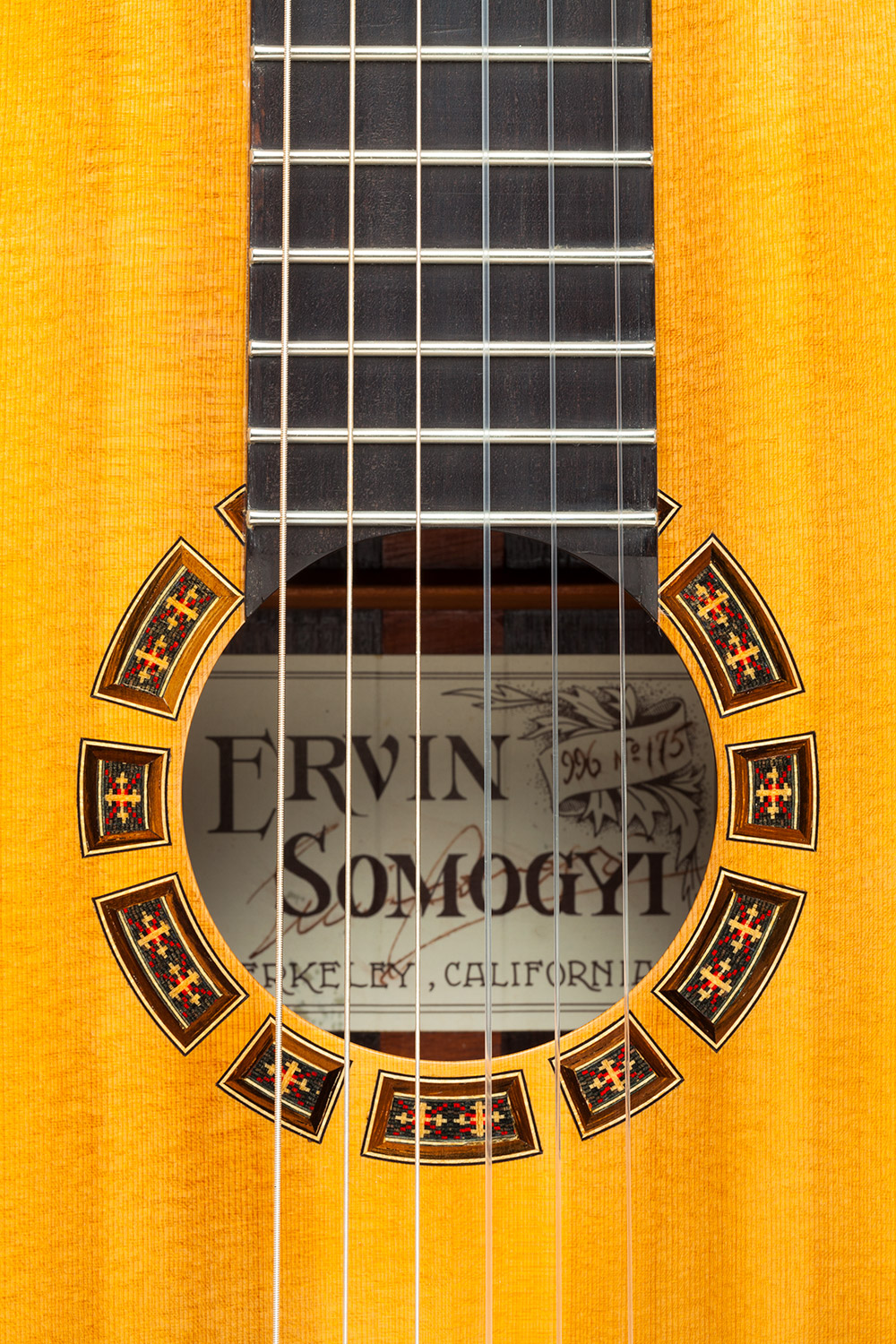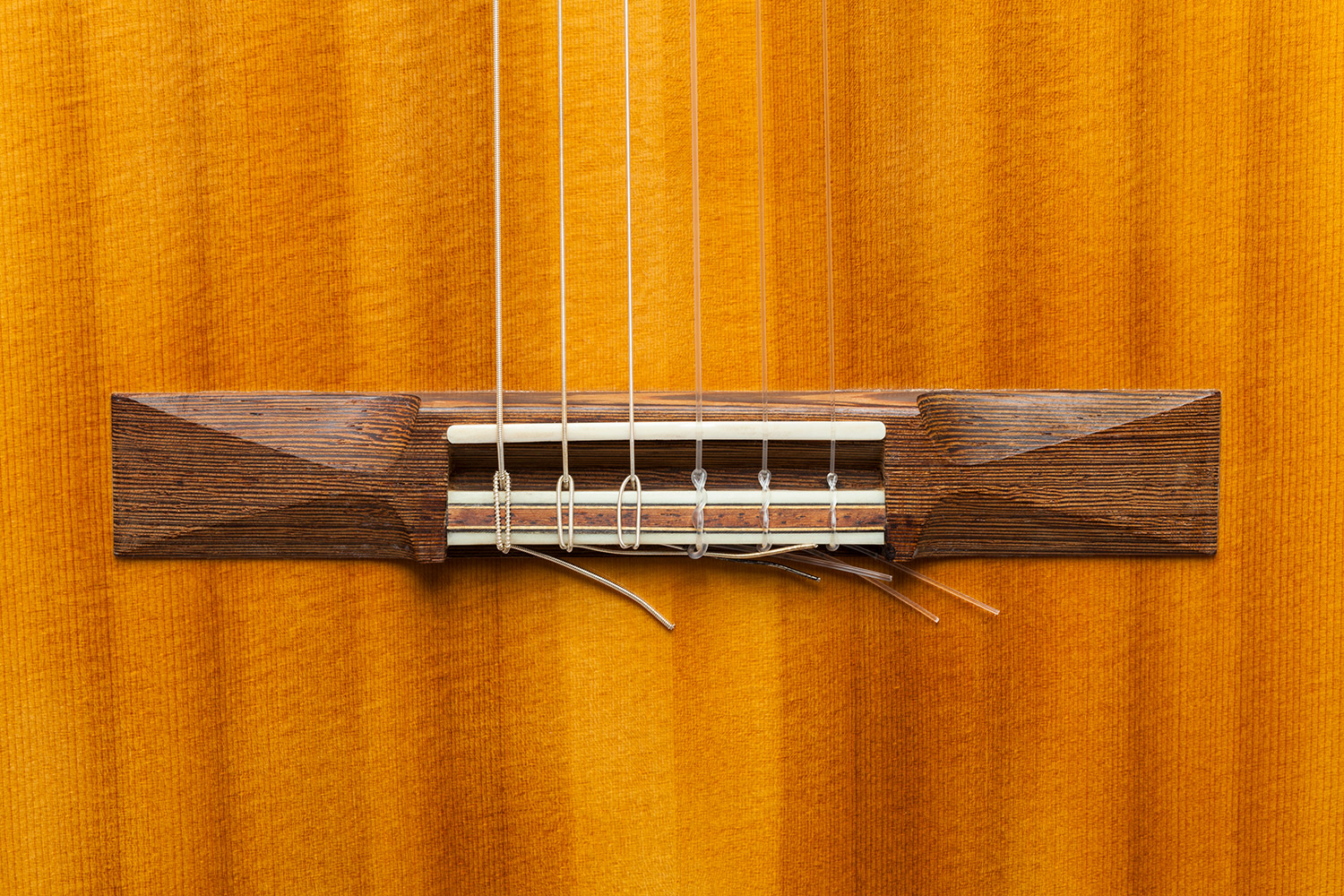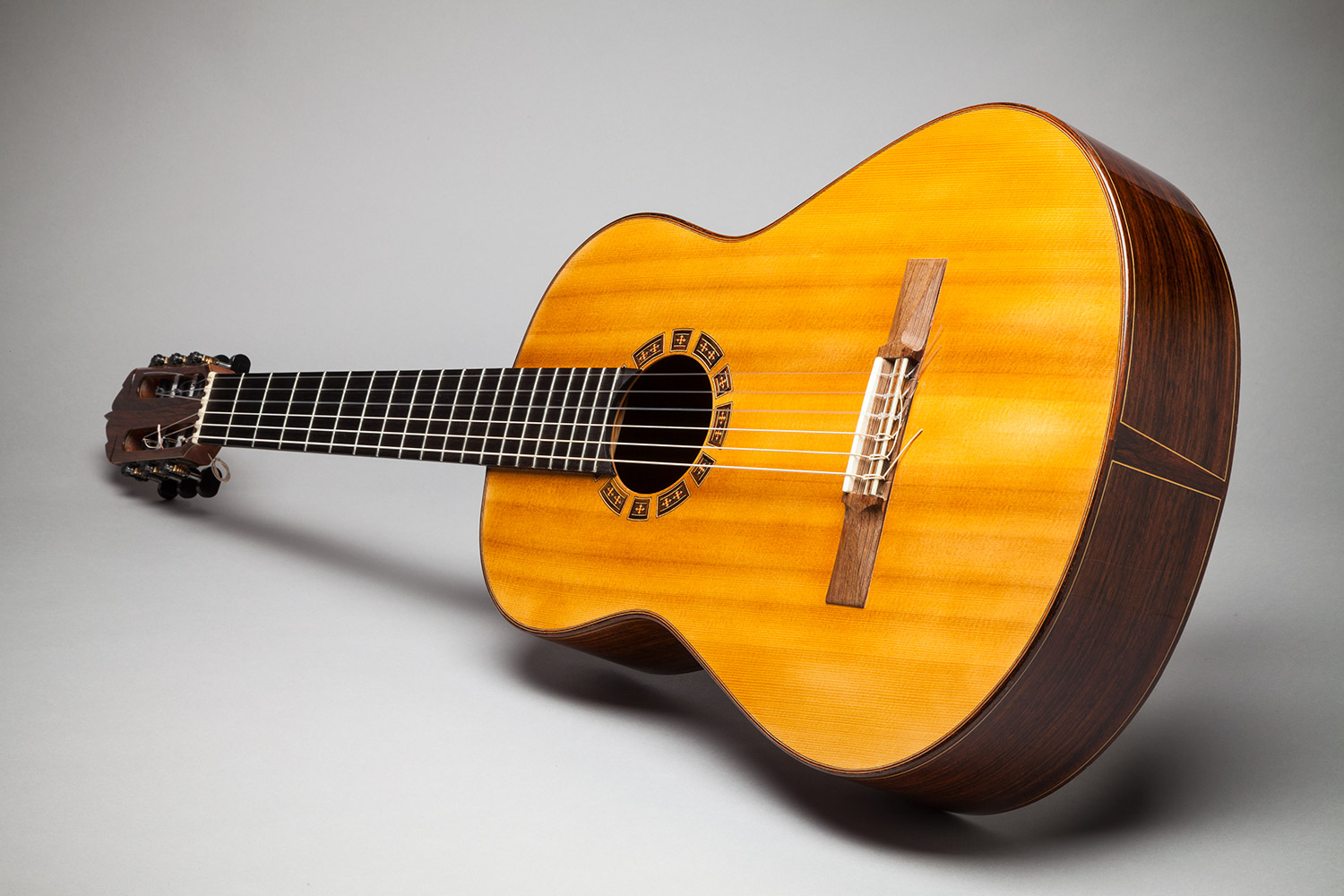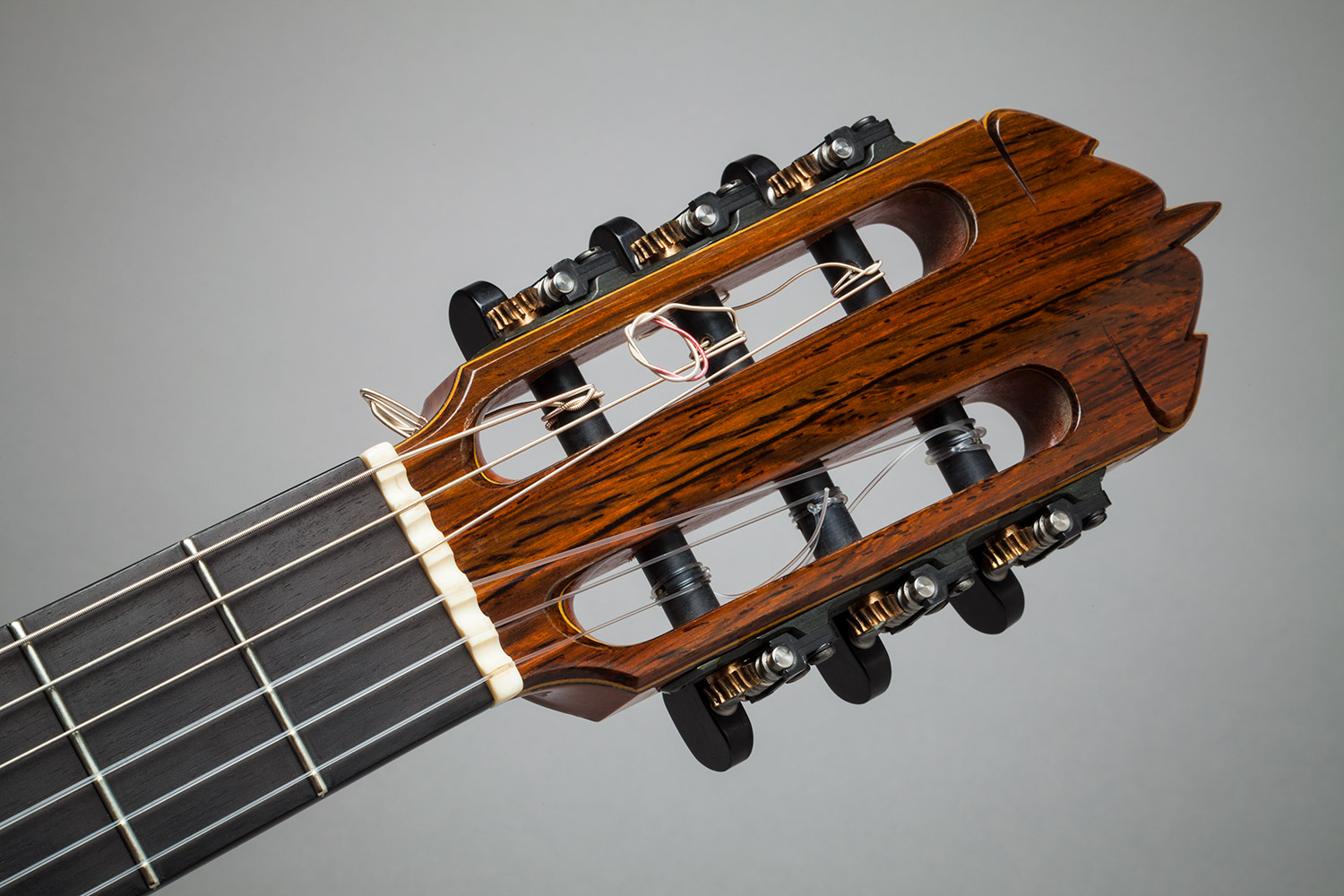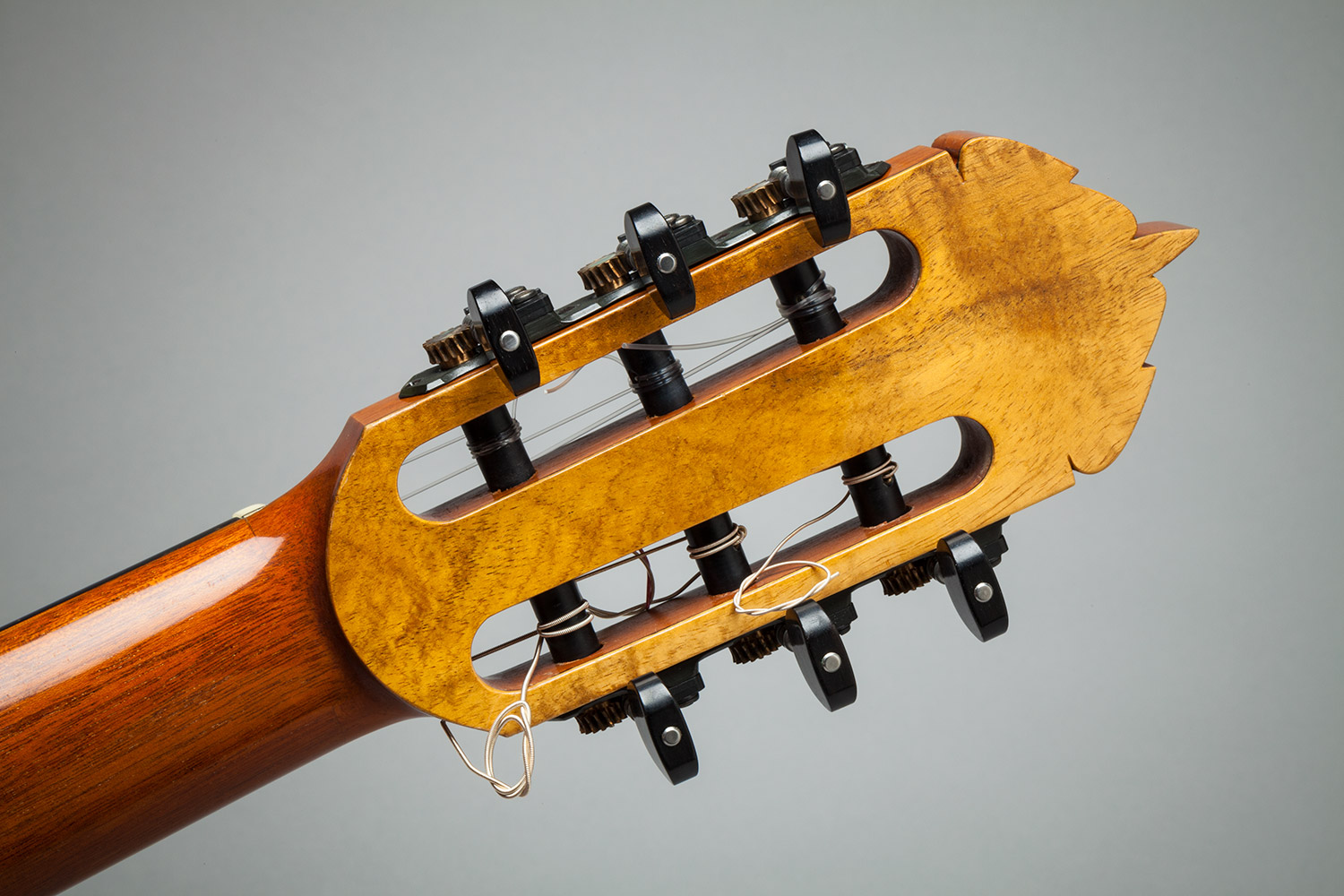This is a classical guitar that I made (Guitar No. 175).
It has the following features (there is also a full verbal description below):
- East Indian rosewood back and sides
- Sitka spruce face (see description below)
- Wenge bridge
- Ebony fingerboard
- Mahogany neck and head
- Gilbert tuning machines
- All wood bindings and construction
- Excellent workmanship throughout
- French polished top (see description below)
- Segmented rosette
- Peghead with front and back decorative veneers
- Bone nut with decorative scalloping
- It plays well and has a lovely sound
PRICE: $24,000 or best offer
Please read the following descriptions about this guitar and its materials. I think you’ll find the information interesting whether you are interested in this guitar by itself or not.
————————–<>————————-
This guitar was originally made in 1996. It was one of a set of three that I made for a group of students at the San Francisco Conservatory of Music. It has lain in storage for a while, as its owner has gone on to other interests than playing the guitar.
When I received it, this guitar needed some minor cosmetic repairs and an action adjustment. Those things were done and then it was completely re-finished, with lacquered back and sides and a French polished face.
ABOUT ROSEWOOD, VS. OTHER SOUNDBOX-WOODS
The modern guitar is comparatively new; it was born in the 1850s, in Spain. Unsurprisingly, a lot of its development (from Spanish guitar to steel string guitar to electric guitar) has been driven by the interests of music and commerce rather than acoustics or dynamics – which areas of scientific inquiry, theory, and research are themselves much younger than the guitar itself. On the other hand, commerce has been around since before the pyramids were built.
Spanish and other European luthiers didn’t distinguish between “classical” and “folk/flamenco” guitars until as late as the mid 1950s. It was around then that the networks of musicians that gravitated to these genres of music coalesced into groups that were identified with this or that kind of guitar. The chief discriminator, at first, was economics. The fans of classical guitar were the more cosmopolitan, urbane, and prosperous and could afford the more expensive exotic woods – such as Brazilian rosewood (Dalbergia Nigra). This was expensive, in part, because it had to be imported (there are no Brazilian-or-any-other-kind-of-rosewood forests in Spain). Also, as I said, wealthier people could afford it.
In the seventy or so years since these categorizations were formalized, luthiers have understood the guitar better and refined its designs, so that guitars can be made that have identifiably different kinds of voices. Therefore, now, one can find guitars that have sounds appropriate to the expression of different musics. This is a huge step forward.
There were other cheaper woods than rosewood available, of course, and the less wealthy people bought guitars made of these. The least expensive wood was Spanish cypress . . . and those instruments were usually bought by “ordinary working people” whose music was folk and informal; they got what later got identified as flamenco guitars.
A BIT OF BACKGROUND ON BOTH THE “SERIOUS” AND “ORDINARY” MUSIC THAT HAS BEEN PLAYED, AND CAN BE PLAYED, ON THIS GUITAR
Andres Segovia made it his life’s work to elevate the guitar above its homely uses by common folk, into the stratospheric heights of it becoming a serious concert instrument for the playing of serious and sophisticated music. He poured his life into that effort, and I respect and admire his heroic** contribution to having the guitar have such a place of honor among musical instruments that rivals that of the piano (there’s no flamenco piano music that I know of). I think that “serious” music is about musical genius of a kind that is so far beyond my own musical abilities that I can only gasp at its compositional, structural, and emotional brilliance.
[** Segovia toured, traveled, and concertized constantly for many decades. If you think that traveling from city to city, from hotel room to hotel room, from restaurant to restaurant, from concert hall to auditorium, from airplanes to cars and taxis and back to airplanes again, and staying nowhere for more than a few days . . . for months at a time, and year in and year out . . . and practicing for hours every day in between performances . . . is not heroic, please rethink this.]
I think equally highly of folk music, however. I think it deserves to be loved fully as much as the music of Beethoven, Liszt, Chopin, Bach, and so many others do. I “get” folk music. It’s not rarified. Anyone can relate to [some part of] it; it’s about people’s lives. It’s about happiness and sadness, love, work, beauty, pain, joy, betrayal, sunshine and rain, animals, death, disappointment, what-I-did-when-I-was-young, lust, war, loss, regret, family, looking backwards and coming to terms with things, and maturation and achievement. None of it seems to have to do with pretentiousness. What is more real than any of this?
East Indian rosewood (Dalbergia Latifolia) was brought into the picture as the supply of Brazilian rosewood dwindled and as the markets grew and target-price-levels changed. East Indian rosewood was an adequate supplement to the guitar’s o.k.-to-build-with list. It is not-quite-so-live as its Brazilian brother, but it’s close, and it’s cheaper, and it’s more stable.
The internal brittleness that makes Brazilian rosewood so tonally attractive also makes it prone to cracking; it’s a rare old Brazilian rosewood guitar that hasn’t had some restorative work done on it. There are luthiers today who refuse to work with Brazilian rosewood for these very reasons. And, having a rosewood that won’t crack when you ship it to some other country with some other climate appeals to any industry that aspires to manufacture goods for a world-wide market.
ABOUT THE SPRUCE TOP ON THIS GUITAR (AND OTHER TOP-WOODS)
Musical instrument makers early on discovered that soundboards made of Spruce made the best and loudest sounds. The first makers being European, they used the woods that they found available: domestic ones. By the time that the [European] guitar acquired a foothold in the United States it had become accepted that a good guitar had to have a European spruce top. The cheap domestic spruce (Sitka spruce) was held to be inferior.
It’s not inferior. It’s just that human beings find it easy to believe that anything that’s exotic is better than anything that’s local. And that’s exactly what “exotic” means: it means “not indigenous to this region” or, more colloquially, “it’s from somewhere else”.
Prejudices, like cockroaches, are difficult to eradicate; they persist. John Gilbert, one of the pioneers of American lutherie, decisively proved that the use of Sitka spruce produced tonal results that were in no way inferior to anything that European spruce can do; one just needed to pay attention to what one was doing.
John Gilbert was an innovative pioneer who was the first luthier to dare to put a non-completely-round rosette around his guitars’ soundholes. Everyone had installed circular inlays around their guitars’ soundholes until he came along; he was the original inspiration for the segmented rosette that is on this guitar.
In any event, the steel string guitar — which is an American invention — never acquired the cachet of the classical guitar and, on account of that, everyone was happy to use the cheaper domestic (Sitka) spruce on it.
That circumstance, however, made Sitka spruce exotic from the point of view of European makers, who prefer to use it on their more top-of-the-line steel string guitars. (And why indeed use the domestic spruce? It’s practically firewood! It grows all over the place and it’s easy to get! But the imported stuff . . . wow . . . that’s got to be better!). Wood suppliers, of course, are happy to validate the rumors.
Ah . . . people . . .
Anyway, time passed. As the world guitar market grew, costs of raw materials also grew. Thus, in the 1960s, the Spanish guitar making community was introduced – by American wood vendors — to an alternative to spruce for guitar tops: red cedar. It could make good sound and it was cheaper than spruce. So it began to be used, and it is now an accepted guitar making wood.
The lesson here is that it doesn’t matter so much where the wood came from; it’s how it was selected for (1) qualities of stiffness-to-weight and (2) what you can do with it that counts. The adage that European spruce [or any kind of spruce] is the best wood is no different from telling people that French women make the best wives. Are they? Well, some are. Some really aren’t. It might be that thirty or forty-weight motor oil is the best thing for your car engine . . . but wood is a lot less consistent from sample to sample than motor oil is.
ABOUT THE FRENCH POLISH AND LACQUER ON THIS GUITAR:
French polish is [the hand-application of] a shellac finish that is at the end rubbed out to a high gloss. It was the traditional and best finish for wood in the days before lacquers, urethanes, catalyzed and ultraviolet-cure finishes, etc., arrived on the scene. French polish has several advantages, and perhaps a few disadvantages. One great advantage is that it is very thin compared with any of the other finishes that are used these days; this allows the guitar’s main diaphragm (the top) maximum freedom of vibratory movement; this results in a louder and more present sound.
French polish is a non-toxic finish (i.e., unlike the modern chemical and synthetic finishes, one can work with French polish all day long and not be poisoned by the fumes), as its solvent is alcohol. One can dissolve shellac flakes in either ethanol or methanol; the principal difference is that one can drink ethanol, but not methanol; the latter is poisonous. [NOTE: Methanol itself was created during Prohibition . . . that period of time in the 1920s when Americans decided that alcohol was a tool of the Devil and needed to be abolished. Accordingly, petrochemical impurities and additives were mixed in with ethanol so as to render it poisonous for humans to drink. As we all know, Prohibition eventually went away; methanol did not. The reason that we still have methanol is that the liquor industry doesn’t want its customers getting their booze from the local hardware store.]
The thickness of a properly applied French polish is anywhere between the thickness of a soap bubble (.001) and the thickness of a sheet of typing paper (.004”). Lacquers are often on the order of .008” to .012” thick, and lacquer is a denser substance than shellac is.
The effect of such few thousandths of an inch of lacquer on a guitar (especially its top) is dramatic. When the guitar is physically complete but not yet finished (i.e., the guitar is “in the white”) the soundbox will have a surprisingly live tap tone. It will make a sound like a drum (that is, depending on who made the soundbox and how). If the guitar is finished in lacquer then the liveness will have pretty much disappeared; the top is constrained from vibrating by the extra mass of the finish — which represents a large proportion of the mass of the wood of the top itself. Guitar makers know that a difference of one or two tenths of a millimeter in top thickness will affect the instrument’s voice; a lacquer finish will add up to 50% yet again the mass of the topwood — which will then be functioning like a top that’s 50% thicker than it was to begin with. Imagine a track athlete who has gained 40 pounds since the last track meet; that’s the new guitar top.
One can sometimes see cracks in the finishes of older lacquer-coated guitars. This is called “crazing”, and it happens because the lacquer is thick and hard enough to crack over time. French polish is much less subject to crazing. The crazing is not a problem; the real problem, as I said above, is the heaviness of the finish.
One disadvantage of French polish is that, because it is so thin, it does not protect a guitar against scratches and wear as does a lacquer finish. French polish is so thin that it offers minimal protection. However, the principal function of any finish — besides enhancing the woods that it covers — is to protect wood against changes in the weather. Wood is hygroscopic; that is, it swells and shrinks depending on how much moisture is in the air. That movement can promote cracking and checking in woods. Therefore, I tell my customers that the function of a French polish is to (1) allow the instrument its full and present voice, and to protect its woods from the weather . . . but not the player. On the other hand, I expect people who own a fine handmade guitar to take reasonably good care of it.
Nonetheless, in case of damage, French polish is easy to touch up by anyone who knows how to work with it. And speaking of knowing how to work with it, mastery of French polishing is a genuine skill; it takes less skill to apply lacquer onto a wooden surface with a spray gun; any high school kid can quickly learn to do that. And along with that, the urethane, polyurethane, and ultraviolet-cure finishes, besides being much more toxic to work with, are not easy to repair in case of any damage. They cannot be spot-finished; the entire finish has to be removed and a new one reapplied.
There is one other thing: lacquers and the synthetics are high-gloss finishes. They are so brightly reflective . . . even “plasticky” . . . that they typically get in the way of one’s appreciating the woods themselves; the reflectivity gets in the way. Take a look at your own lacquered guitar and you’ll see what I mean. A French polish is shiny but not so glossy that it gets in the way of appreciating the colors and visual depth of the woods; these look more beautiful, and have more depth even indoors where there is artificial lighting.
THE ROSETTE:
The rosette is the traditional decorative inlay around the soundhole. It is a functionally completely useless component whose function is to enhance the look of the instrument. Its original job was to keep bad spirits away. Really. Centuries ago, when wooden string instruments were first being invented and made, it was believed that devils would inhabit the dark recesses behind the soundholes. Accordingly, beautiful designs were brought in that were thought to discourage these bad spirits from settling into the dark areas inside lutes, citterns, mandolins, theorbos, and proto-guitars. More recently, the job of the rosette has been to beautify the instrument. As I said, it doesn’t really do anything else; it does not affect playability, tone, projection, or sustain.
Factories install the easiest and most trouble-free rosettes that they can; frequently these are two or three concentric circles made of either plastic or wood. Luthiers frequently go to all kinds of trouble to make rosettes that are distinctive and unique. These too are typically circular and they are often of wood mosaic designs where a design element is repeated all around. Such rosettes typically contain between 3,000 and 4,000 little pieces of wood.
The rosette on this guitar is a wood mosaic one, but it is different in that it is not a continuous circle. It’s more trouble to make one of these, but I think that such segmented inlays are more distinctive.
WENGE
Wenge (pronounced wen-gay, and not wenj) is an African hardwood that is very live: it’s stiff and brittle enough to make good sound. It hasn’t been discovered by guitar makers, in part (I think) because it is so brittle. You practically can’t walk past it without getting a splinter. Also, it’s rather plain to look at. But it really is a good guitar making wood; I know that from experience.
Other not-quite-yet-discovered-by-guitar-makers woods that are tonally superior are osage orange and padauk (pronounced padook).
ON LIKING AND LOVING A GUITAR
Life is famously short and I believe that, in general, people ought to have as much or as many of the things that they want. If you are a friend of the guitar then you’ll want a guitar that you really like, and can quickly learn to love. This guitar is very good by most standards, but I don’t know whether or not this guitar would be perfect for you.
As far as trying a guitar out to see whether you like it or not, there are two options. First: you come to my shop and play the guitar. Second, you pay for the guitar and I ship it to. You then have a week to play it and evaluate it, before you have to make up your mind as to whether you wish to keep it or return it. If after a week you decide that this is not the guitar for you then you pack it up and return it and I refund you your money – minus whatever it costs to fix, repair, re-finish, etc. whatever dings or scratches you might inadvertently have subjected the guitar to. I’ll pay for shipping. Please let me know if you have any questions or comments.
THIS GUITAR’S SOUND
MANDATORY SURGEON GENERAL’S WARNING: The sound of Somogyi’s guitars has been found to be so intoxicating that you are seriously warned to not play any of them while driving or operating heavy machinery.


